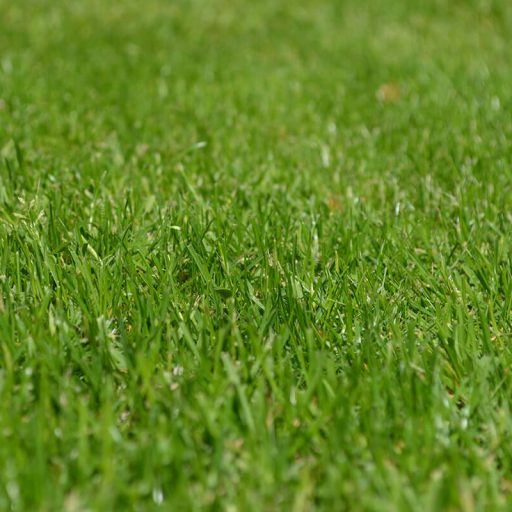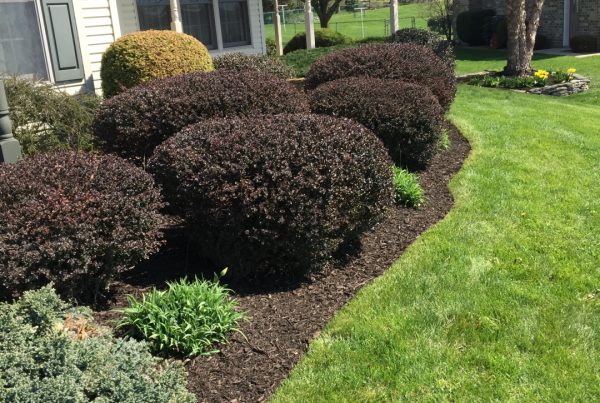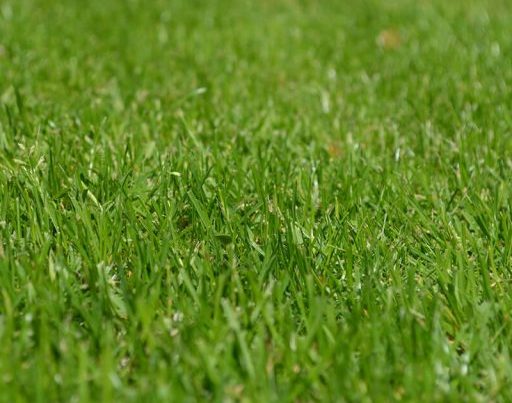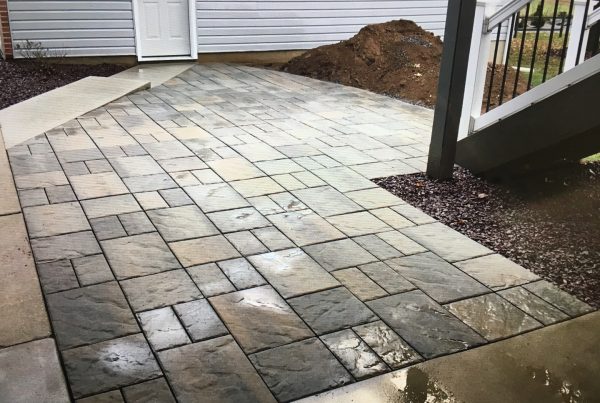Turf Management,
Difinition – Turf Management is the management of your turf/lawn through the seasons.
Turf management starts from day one when the lawn is installed. Once the lawn is installed and covered with straw the watering begins. The lawn should be watered daily all of the growing season that the lawn was installed unless it rains that day. Let me stress when I say rained that day I dont mean a shower Im talking a nice light to steady all day rain. After about six to eight weeks a fertilization and weed control treatment should be applied according to the label on the bag. Mowing should take place when the new lawn reaches about three and half inches to four inches. The mower should be set on three to three and half setting. You should never take more than a quarter inch at one time off the cut. Taking more than a quarter inch will cause the blade not to cut properly and pull at the blade of the lawn. The lawn should have a scheduled maintenance program yearly so the lawn grows properly and healthy year after year. The scheduled maintenance program includes Overseeding, Fertilizations, Weed Control, Aerations, Liming, Dethatching and Pest Control. Not all of these scheduled items may need done yearly may be every two years. Your asking yourself where do I start for my program? The first step is a soil test if one wasnt performed when the new lawn was installed. A soil test provides important information about the nutrients present in the soil. The proper pH should be between 6.5 and 7.0 which is slightly acidic. To high of pH causes the lawn not to be able to absorb proper nutrients. The soil test also will read Phosphorus and Potassium. The soil test will recommend what fertilization program to use for lawn. The soil test also will tell you what amount of lime your lawn needs if the pH is off. Usually anything over 100 pds / per 1000 square feet will need two applications. This would be the recommended application at this point. 50 pounds / 1000 square feet in two different applications. Once you establish your fertilization program then you will want to look at weed control program. A weed control program is a program that controls the weeds in your lawn through out the seasons. Usually two weed control treatments are performed for the growing season. Now its time to look at Aeration, Aeration is the process of pulling plugs from your lawn to help the lawn receive oxygen and get nutrients and water to the roots of the turf. Aeration is a very important part of the growing process of the lawn. I recommend performing this in the Fall of each growing season. The reason I prefer Fall it allows the holes to stay open all Winter and allows the Winter snow and rain really absorb into the ground. Some Contractors perform aeration in the Spring but then your mowing and plugging the holes shut quickly. Dethatching would be the next project on your list. Dethatching is also performed in the Fall. Dethatching is the removal of all the dead grass that died over the Summer or mowing clippings from using a mulching kit. Thatch up to a quarter inch is fine. Dethatching in the Spring can pull new growth out while pulling the dead out. Another good part of dethatching in the Fall is most home owners overseed in the Fall dethatching helps loosen the soil fro the seed to germanate. Speaking of overseeding that would be the next project. Overseeding is the seeding of the lawn yearly to replace any dead or not growing well lawn areas. This is usually performed in the Fall or Spring. I recommend Fall because again with aeration the seed is able to penetrate the soil and allow it to germinate quickly. Overseeding is usually half the rate of seed being installed when you seeded your lawn from new. The last project is Pest Control for the seasons. The pest control program is a highly disussed program. I recommend the program highly. The home owner puts all his or her time in keeping the lawn nice with all the other programs why chance a pest destroying the complete lawn in weeks. In Pa. we have multiple pest in the lawn. These are the top pest in Pa. Chinch Bug, Mole Crickets, Fleas, Ticks and white Grubs. The Grubs in my eyes are the most destroying pest ever. Grubs can destroy a lawn in weeks after you have worked so hard to get a nice lawn. The Grub feeds on the root system of the lawn and that in return kills the lawn. The treatment for Grubs works well and has treat return. The treatment is usually installed in July for most products. The home owner will start seeing Grub damage as soon as September and as early as April of the next year in Pa. if no treatment is performed. Below are the difinitions and scheduled dates of your Turf Management ( Please note treatment dates are for Pa. Residents other States may very slightly on treatment times. ) Hope they help you!
Difinitions,
Soil Test – Collection of Data on your soil, pH, Phosphorus and Potassium. Needed information for the best lawn results.
pH – Acidic amount in the lawn. Lawns should be 6.0 – 7.0 pH.
Phosphorus – Primary nutrient that involves metabolic processes.
Potassium – the nutrient uptake helping synthesize proteins and starches.
Lime – Soil Amendment of Calcium, Carbonate and Magnesium Carbonate.
Seeding – The prepping of soil and installing seed and straw to make a new lawn.
Overseeding – The seeding of small patches or bare patches from a object or weather killing the area. Aeration or Dethatching is a must to loosen soil beofre overseeding.
Sodding – The process of loosening the soil then installing cut mats of grass and pinning the mat down on the prepared soil. Extreme watering and care is needed for sodding.
Fertilization – The use of materials and mixtures to improve necessary plant nutrients.
Weed Control – The use of materials and mixtures to improve one or more necessary plant nutrients.
Pest Control – The treatment to control Lawn Pest ( Chinch Bugs, White Grubs, Sod Webworm ) that eat on the root system of your lawn. Performed during the pest time period.
Turf Disease – A Pathogen that causes turf disease and usually only visible by microscope or comparable machine. Usually caused by weather conditions.
Aeration – Process of removing plugs or punching holes from the soil in order to break up soil compaction allowing oxygen and water to reach the root zone.
Dethatch – Dethatching is the process of removing excess thatch ( dead Grass Particles and debris ) that layes between the grass blades and soil to allow water and oxygen to enter.
Mowing – The act of leveling or cutting down grass.
TURF MANAGEMENT CALENDAR FOR TREATMENTS.
*PLEASE NOTE THIS CAN VERY DEPENDING WHERE YOU LIVE AND THIS IS BASED ON SOUTHERN PA. AREA. FURTHER NORTH OR OTHER STATES MAY BE DIFFERENT AT TIMES.
TREATMENTS AND SEEDING AT THE WRONG TIMES ARE A WASTE OF MATERIALS AND TIME AS THEY ARE NOT AFFECTIVE. THIS IS APPLIED TO FERTILIZATION AND PEST CONTROL. ( TIMING IS EVERYTHING )
SCHEDULED TIMING OF TREATMENTS,
( TREATMENTS ) ( TIME PERIOD )
SEEDING – APRIL – MAY. AND LATE AUGUST – EARLY OCTOBER.
OVERSEEDING – FEBUARY – MID MAY. AND LATE AUGUST – EARLY OCTOBER.
SODDING – MARCH – MAY. AND SEPTEMBER – OCTOBER.
FERTILIZATION – MID APRIL – JUNE. AND MID AUGUST – OCTOBER.
LIMING – FEBUARY – MAY. AND SEPTEMBER – NOVEMBER.
DETHATCHING- APRIL – MAY. AND SEPTEMBER – OCTOBER.
AERATION – MARCH – MID MAY. AND SEPTEMBER – OCTOBER.
MOWING – MARCH – NOVEMBER. 31/2 – 4.0 INCH WEEKLY CUT AND LAST CUT OF SESASON 3.0 INCHES.
CRABGRASS CONTROL – MID MARCH – MAY.
BROADLEAF CONTROL – MID APRIL – MAY. AND SEPTEMBER – MID OCTOBER.
( PEST CONTROL )
GRUBS – MID MAY – JUNE. AND AUGUST – SEPTEMBER.
CHINCH BUGS – JUNE – SEPTEMBER.
SOD WEBWORM – MID JUNE – MID SEPTEMBER.
APPLING MORE THAN THE RECOMMENDED ON THE BAG IS HARMFUL TO THE TURF AND CAN KILL THE TURF AND ALSO IT IS ILLEGAL TO APPLY MORE THAN RECOMMENDED AMOUNT ON THE BAG. IF THE TURF IS KILLED YOU WILL NEED TO REMOVE ALL OF THE OLD TURF AND RESEED THE COMPLETE AREA.
IN DRY HOT WEATHER WHEN THERE IS DROUGHT CONDITIONS PRESENT WE RECOMMEND HOLDING OFF SOME TREATMENTS AS IT MAY HARM THE TURF. IF YOUR NOT SURE IF YOU SHOULD MAKE A APPLICATION PLEASE CALL OUR TRAINED STAFF AND THEY WILL BE MORE THAN HAPPY TO HELP YOU OR ASK YOUR LOCAL SUPPLIER FOR DIRECTIONS. ( REMEMBER TIMING IS EVERYTHING!!! )
IF YOUR NOT SURE ON YOUR TIMING PLEASE FEEL FREE TO CONTACT OUR OFFICE FOR HELP OUR TRAINED STAFF CAN DIRECT YOU IN THE RIGHT DIRECTION ON TIMING AND MATERIALS TO BE USED.






